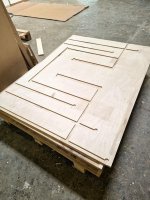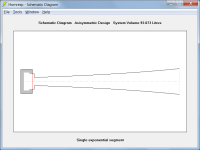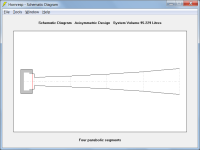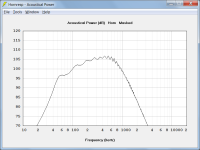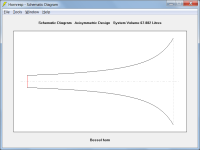The problem is 99% of people are not building cylinder shaped horn subwoofers.
Why should that be a problem?
Conical (straight) and exponential (curved) segments mean the top, bottom, and both sides are expanding. 99% of the people are not building those enclosures either.
Again, why is that an issue?
The only horn profile that 99% of people are building is parabolic, whether the horn is negative, straight, or positive flare or the enclosure is direct radiator or bandpass...I E square or rectangular enclosures.
In that case, presumably they will choose the Par flare option in any simulations done using Hornresp.
A circle can be converted to a square.
Not sure that I understand. Do you mean that a circle can be converted to a square:
Having its side length equal to the circle diameter,
Having its diagonal length equal to the circle diameter,
Having an equivalent perimeter length,
or
Having an equivalent area?
4 or more expanding sides cannot be converted to 2 expanding sides PHYSICALLY.
Again, I am not sure what you mean. As mentioned previously, it is how the cross-sectional area changes with axial length that determines the horn type, not what it may physically look like.
Consider the following very simple example of a conical horn having:
S1 = 2500 cm^2
S2 = 10000 cm^2
L12 (Con) = 100 cm
Axisymmetric conical horn:
Diameter profile:
Equivalent square cross-section conical horn with throat 50 cm x 50 cm and mouth 100 cm x 100cm:
Height profile:
Width profile:
Equivalent rectangular cross-section conical horn with throat 50 cm x 50 cm and mouth 50 cm x 200 cm:
Height profile:
Width profile:
In all three cases the cross-sectional area expands at the same rate from 2500 cm^2 to 10000 cm^2 along the 100 cm length of the conical horn.
You stated HR is based on cylindrical segments. That can be converted to rectangular segments.
A model that SHOULD have ALL expanding sides cannot be BUILT into a 2 parallel sided enclosure and expect the built PAR enclosure to measure the same as the modeled CON or EXP enclosure.
Now, a PAR enclosure can have an exponential expansion rate, but is not an EXP enclosure.
The purpose of HR defaulting to PAR is to prevent bad habits. Folks are using CON because it's already there. Like I said before, 99% of people are NOT building an enclosure with ALL expanding sides.
CON = ALL straight expanding sides.
NO PARALLEL SIDES.
EXP = ALL curved expanding sides.
NO PARALLEL SIDES.
PAR = 2 expanding, 2 non-expanding, or 2 negative expanding sides.
TWO PARALLEL SIDES.
Good luck trying to fold a CON or EXP enclosure in reality. You would need the same technology they use to make brass horn instruments. I suppose you could 3D print a CON or EXP enclosure.
99% of the people in this SUBwoofer thread BUILT PAR enclosures.
A model that SHOULD have ALL expanding sides cannot be BUILT into a 2 parallel sided enclosure and expect the built PAR enclosure to measure the same as the modeled CON or EXP enclosure.
Now, a PAR enclosure can have an exponential expansion rate, but is not an EXP enclosure.
The purpose of HR defaulting to PAR is to prevent bad habits. Folks are using CON because it's already there. Like I said before, 99% of people are NOT building an enclosure with ALL expanding sides.
CON = ALL straight expanding sides.
NO PARALLEL SIDES.
EXP = ALL curved expanding sides.
NO PARALLEL SIDES.
PAR = 2 expanding, 2 non-expanding, or 2 negative expanding sides.
TWO PARALLEL SIDES.
Good luck trying to fold a CON or EXP enclosure in reality. You would need the same technology they use to make brass horn instruments. I suppose you could 3D print a CON or EXP enclosure.
99% of the people in this SUBwoofer thread BUILT PAR enclosures.
Last edited:
You can sum a few PAR segments that gradually expand (horn shapes) as an EXP and get a measured result that’s very similar to the HR simulation. (Especially if you looked at the volume/length of each section and described them appropriately)?
this has already been shown with various illustrations of stepped expansions, etc
this has already been shown with various illustrations of stepped expansions, etc
I already stated that PAR segments can have exponential expansion rate. It's still not an exponential horn. ALL SIDES HAVE TO EXPAND, not just 2.You can sum a few PAR segments that gradually expand (horn shapes) as an EXP and get a measured result that’s very similar to the HR simulation. (Especially if you looked at the volume/length of each section and described them appropriately)?
this has already been shown with various illustrations of stepped expansions, etc
Check out car horns. They are exponential whether straight or folded.
Parabolic enclosures are not as efficient as conical or exponential enclosures.
Parabolic enclosures are easier to build for us DIYers.
All 3 pics are EXP enclosures.
If you are not BUILDING these types of enclosures, then you SHOULD model with PAR.



Parabolic enclosures are not as efficient as conical or exponential enclosures.
Parabolic enclosures are easier to build for us DIYers.
All 3 pics are EXP enclosures.
If you are not BUILDING these types of enclosures, then you SHOULD model with PAR.
How many cabinets have you built and measured and compared to your hornresp sims and then adjusted your descriptions or data entry that was in error in order to understand all of this better and more appropriate/accurate?
Have you built 3 enclosures for the same driver, 1 CON HR model, 1 EXP HR model, and 1 PAR HR model, with the same throat, mouth, and length, and all the measured data were the exact same?
I think youre too busy arguing and not realizing the different ways to estimate/describe these(or any) shapes in horn response to get a simulation ‘closer’ to the measured results.
I see it all the time, "my measurements don't match my model." 1st thing I noticed is they modeled with CON, EXP, or my favorite...CON & EXP.
I'd love to see an enclosure where the 1st segment has 4 straight expanding sides and then the 2nd segment has 4 curved expanding sides.
i Need to manipulate LE more often then not to get the measured freq response shape to resemble the horn response simulation.
the actual TS parameters and real Cms/VAS are often culprit . The dats isn’t ’perfect‘ ever either….
Fb and the rest of the pipe resonaces are incredibly close to the landmarks in hornresponse. Because of the shape/geometry/volume and length of the qw resonators described.
line the driver up to cancel out a pipe resonace in horn response and then change the ‘exp/con/par’.. if it’s barely misaligning that location with driver position then it’s probably not going to be a big deal in the actual subwoofer ? What metric can you use to evaluate this inaccuracy your troubled with?
the actual TS parameters and real Cms/VAS are often culprit . The dats isn’t ’perfect‘ ever either….
Fb and the rest of the pipe resonaces are incredibly close to the landmarks in hornresponse. Because of the shape/geometry/volume and length of the qw resonators described.
line the driver up to cancel out a pipe resonace in horn response and then change the ‘exp/con/par’.. if it’s barely misaligning that location with driver position then it’s probably not going to be a big deal in the actual subwoofer ? What metric can you use to evaluate this inaccuracy your troubled with?
Last edited:
The only metric I use is what is physically being built. All my built enclosures have at least 2 parallel walls.
Just like anyone else, I'd love to have an exponential horn subwoofer. But I know it's not going to happen. 1, I'm too lazy to do it. 2, it gonna be too big to move around. 3, I know the wife would itch.
Just like anyone else, I'd love to have an exponential horn subwoofer. But I know it's not going to happen. 1, I'm too lazy to do it. 2, it gonna be too big to move around. 3, I know the wife would itch.
So I checked out the waveguides on partsexpress.com. The only parabolic design seems to be the Eminence WG Line Array.
All the other waveguides have either conical or exponential designs...ALL the sides are constantly expanding from throat to mouth.
2 parallel sides are convenient for nice and tidy rectangular enclosures with ease of build and mobility. They are just not as efficient as conical or exponential enclosures.
When someone shows me a built 2 parallel sided enclosure that measures EXACTLY like a CON or EXP HR model, then I'll change my tune.
All the other waveguides have either conical or exponential designs...ALL the sides are constantly expanding from throat to mouth.
2 parallel sides are convenient for nice and tidy rectangular enclosures with ease of build and mobility. They are just not as efficient as conical or exponential enclosures.
When someone shows me a built 2 parallel sided enclosure that measures EXACTLY like a CON or EXP HR model, then I'll change my tune.
You stated HR is based on cylindrical segments. That can be converted to rectangular segments.
Hornresp is not based on cylindrical segments. Cylindrical is simply one of eleven available options that can be used, depending upon the circumstances. I indicated in Post #14,654 that the paraflex design I showed would be modelled using cylindrical segments because it was made up of a series of rectangular cross-section, non-expanding ducts.
As indicated in Post #14,641 Hornresp has the following options for segment flare:
Con, Exp, Par, Bes, Hyp, Lec, Obl, Rad, Sph and Tra.
(Cylindrical segments can be specified by using either Con, Exp or Par and setting S1 equal to S2).
A model that SHOULD have ALL expanding sides cannot be BUILT into a 2 parallel sided enclosure and expect the built PAR enclosure to measure the same as the modeled CON or EXP enclosure.
The predicted performance of a system modelled as an exponential horn will obviously not be exactly the same as the measured results for a system built using a series of Par segments to approximate the exponential flare. The point that Booger weldz was making in Post #14,664 is that if the expansion rate is gradual, the results can however be very close indeed, as shown in the attachments.
Attachment 1 - Single axisymmetric exponential segment
Attachment 2 - Equivalent four axisymmetric parabolic segments
Attachment 3 - Comparison of exponential and parabolic results
The difference in results can be barely seen.
Now, a PAR enclosure can have an exponential expansion rate, but is not an EXP enclosure.
Not sure what you mean by a PAR enclosure. If an enclosure has an exponential expansion rate then it should be modelled using the Exp flare option.
The purpose of HR defaulting to PAR is to prevent bad habits. Folks are using CON because it's already there.
Already there as the default? Where?
CON = ALL straight expanding sides.
NO PARALLEL SIDES.
As mentioned several times already, horn flare is defined by the rate of area expansion.
Attachments 3 and 4 in Post #14,662 show that a rectangular cross-section conical horn can have two parallel sides and two curved sides. The same applies to an exponential horn.
Good luck trying to fold a CON or EXP enclosure in reality.
The back-loaded design shown in Post #14,654 is an example of a folded exponential horn in a rectangular enclosure.
You cannot tell me that these 3 enclosures will MEASURE the exact same if they had the exact same throat, mouth and length.
No one has said that.
It's still not an exponential horn. ALL SIDES HAVE TO EXPAND, not just 2.
The statement is simply not true.
How many bull horns or cheerleader horns has anyone seen with 2 parallel sides???
I have seen one, but unfortunately I do not have a photograph of it to post.
The two flat parallel sides were wedge (triangular) shaped, expanding from a width of about 5 cm at the throat end to a curved exit at the mouth end. The length would have been about 50 cm and the width at the mouth was about that also. The two parallel sides were separated by approximately 5 cm. The horn had a parabolic expansion rate, obviously.
Check out car horns. They are exponential whether straight or folded.
The examples you show are not exponential horns, they have a Bessel flare or similar. See the example of a Bessel horn in Attachment 4.
When someone shows me a built 2 parallel sided enclosure that measures EXACTLY like a CON or EXP HR model, then I'll change my tune.
If the built enclosure has a parabolic flare but is modelled using either a conical or exponential flare, then obviously the results will be different.
No matter how close the horn models are, Hornresp simulation predictions will never exactly match measured results anyway because of inherent limitations in the lumped parameter driver model.
There is probably little point in continuing this discussion as it seems that your mind is firmly made up, and that anything Dr Kolbrek, Booger weldz or I say is unlikely to change your thinking.
(I assume you are aware that Dr Kolbrek is a recognised authority on horn loudspeaker theory and design and is the co-author of the quite remarkable "High Quality Horn Loudspeaker Systems - History, Theory & Design" book. In the past he has worked as a senior research engineer on the design and development of horn loudspeakers at Celestion International in the United Kingdom, and has presented papers on horn loudspeaker design and horn loudspeaker simulation at different AES Conventions. If anyone knows what they are talking about when it comes to horn loudspeakers, it is Bjørn.)
Attachments
Last edited:
Doesn’t an appropriate exponential ‘horn’ need to have a mouth opening shape as big as the 1/2 wavelength of Fb?The only metric I use is what is physically being built. All my built enclosures have at least 2 parallel walls.
Just like anyone else, I'd love to have an exponential horn subwoofer. But I know it's not going to happen. 1, I'm too lazy to do it. 2, it gonna be too big to move around. 3, I know the wife would itch.
some of these things aren’t just inconvenient, they’re physically impossible? (~28.8 hz and ~6 meters? as in 360000cm2 ?
- Home
- Loudspeakers
- Subwoofers
- Hornresp
